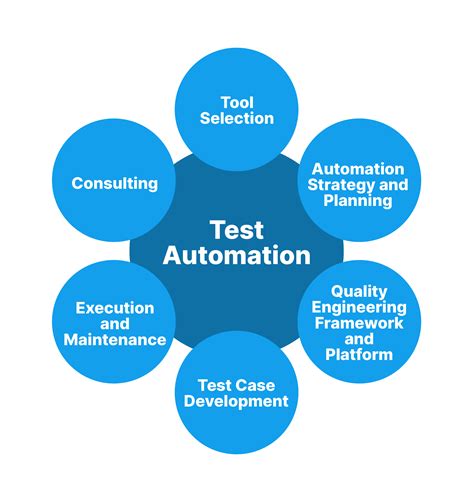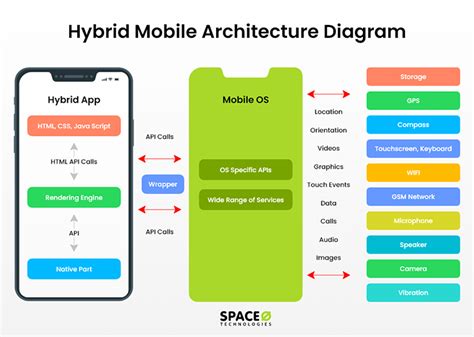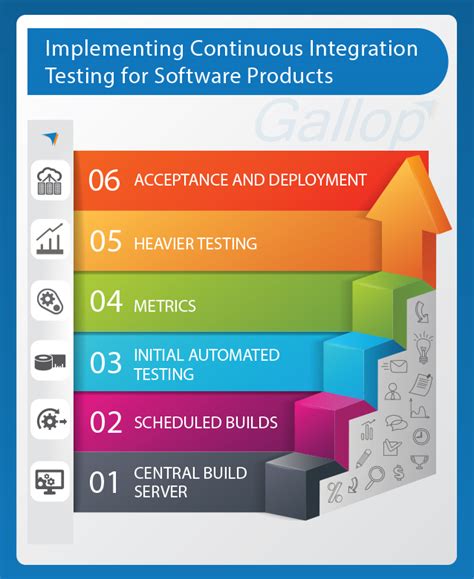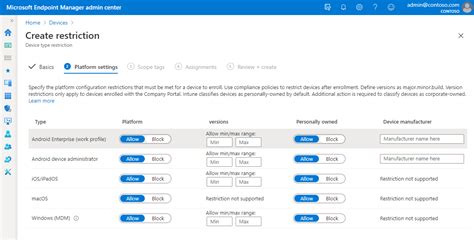In the fast-paced world of mobile development, it is crucial to ensure the smooth functionality, stability, and user-friendliness of Android and iOS applications. Constant innovation and increasing user expectations have paved the way for the adoption of automated testing techniques, which have become an indispensable component of the development process. The utilization of cutting-edge techniques and tools can significantly enhance the effectiveness of testing, allowing developers to detect and address potential issues early in the development cycle.
Automated testing provides developers with the means to simulate user interactions, validate the app's performance under various scenarios, and identify critical bugs and regressions. By automating the testing process, developers can decrease the time and effort required for manual testing, reducing the overall development cycle and accelerating time to market. Additionally, it allows teams to allocate more time and resources towards refining and enhancing the application's core functionality, resulting in a higher quality end product.
Ensuring the reliability of mobile applications across different devices, operating systems, and versions is a critical objective for developers. Automated testing enables them to validate the compatibility of the app with a wide range of configurations, ensuring a consistent experience for users. Moreover, it streamlines the onboarding process for new team members, allowing them to quickly familiarize themselves with the project and promptly contribute to the testing efforts.
Efficiency, accuracy, and scalability are inherent advantages of utilizing automated testing in the development of Android and iOS applications. This article aims to explore various recommended practices that can significantly improve the efficacy of automated testing. From selecting an appropriate testing framework to designing comprehensive test suites, we will delve into the key considerations and strategies that can assist developers in delivering top-notch mobile applications.
The Significance of Automated Testing in Application Development

Automated testing plays a pivotal role in the development of applications, acting as a crucial step towards ensuring the overall quality and performance of the software. By leveraging automated testing techniques, developers can effectively identify and rectify various defects, enhance the user experience, and boost the overall efficiency of their applications.
- Enhancing Efficiency: Automated testing eliminates the need for manual, repetitive testing procedures, thereby reducing human errors and saving significant time and effort. This allows developers to focus more on other critical tasks, such as implementing new features and refining the application's functionality.
- Ensuring Quality: By automating the testing process, developers can thoroughly evaluate the application's functionality, performance, and compatibility across different devices and operating systems. This helps in identifying any potential issues or bugs that may adversely affect the user experience and allows for timely resolution.
- Increasing Test Coverage: Automated testing enables developers to conduct extensive and comprehensive testing across various scenarios, ensuring maximum test coverage. This allows for the identification of corner cases and rare scenarios that may have been missed during manual testing, thereby resulting in a more robust and reliable application.
- Facilitating Continuous Integration and Deployment: Automated testing seamlessly integrates with the development pipeline, enabling continuous integration and deployment. This ensures that every code change is thoroughly tested, minimizing the risk of introducing new bugs or regressions into the application.
- Enabling Regression Testing: As applications grow and evolve, it becomes essential to perform regression testing to ensure that previously fixed bugs do not resurface. Automated testing allows for the easy execution of regression test suites, thereby facilitating the identification of any unintended side effects caused by recent changes.
In conclusion, automated testing is of utmost importance in application development as it enhances efficiency, ensures quality, increases test coverage, facilitates continuous integration and deployment, and enables effective regression testing. By incorporating automated testing practices into the development process, developers can build robust, reliable, and high-performing applications.
Choosing the Right Testing Framework
In the quest for efficient and reliable automated testing of mobile applications, selecting the appropriate testing framework plays a pivotal role. While there are several options available, making the right choice can significantly impact the effectiveness and success of the testing process.
1. Evaluate Compatibility: Before settling on a testing framework, it is crucial to assess its compatibility with the target platforms, Android and iOS. A comprehensive evaluation ensures that the chosen framework seamlessly integrates with both operating systems, enabling efficient testing across different devices and versions.
2. Consider Test Coverage: One key aspect to consider is the test coverage provided by the testing framework. A robust framework should support a wide range of testing scenarios, such as UI testing, unit testing, and integration testing. This ensures comprehensive coverage of the application's functionalities and helps identify potential bugs or issues in different areas of the codebase.
3. Assess Cross-Platform Support: For organizations aiming to develop applications for both Android and iOS, selecting a testing framework with cross-platform support becomes imperative. This allows for simultaneous testing on multiple platforms, increasing efficiency and reducing the time and effort required for testing each platform individually.
4. Examine Community Support: The presence of an active and supportive community around a testing framework is an essential factor to consider. A strong community provides access to valuable resources, extensive documentation, and a network of experienced developers who can offer guidance and assistance when needed. This support can greatly facilitate the learning process and troubleshooting during the testing phase.
5. Evaluate Test Execution Speed: The efficiency of the testing framework in terms of execution speed can significantly impact the overall testing process. A framework that allows for speedy test execution enables quicker feedback on the application's performance, leading to faster bug detection and resolution.
6. Consider Integration with CI/CD Tools: Integration of the testing framework with Continuous Integration and Continuous Deployment (CI/CD) tools is crucial for seamless integration into the development workflow. Choosing a framework with robust integration capabilities ensures automated testing can be seamlessly incorporated into the CI/CD pipeline, enabling efficient and continuous testing throughout the application's lifecycle.
Conclusion: The process of selecting the right testing framework for automated testing of Android and iOS applications requires careful consideration of compatibility, test coverage, cross-platform support, community support, test execution speed, and integration with CI/CD tools. By evaluating these factors, organizations can make informed decisions that contribute to effective and successful automated testing strategies.
Understanding the Architecture of Mobile Apps for Effective Testing

In order to ensure successful and efficient testing of mobile applications, it is crucial to have a deep understanding of the app's architecture. By delving into the intricacies of how the app is structured and organized, testers can identify potential areas of weakness and focus their testing efforts on those specific components.
Exploring the architecture of a mobile app involves comprehending its different layers, modules, and components. This understanding allows testers to evaluate the dependencies between various elements and ensure that they are functioning seamlessly together. By gaining insight into the app's architecture, testers can also better comprehend the flow of data and interactions across different screens or modules within the app.
Furthermore, understanding the architectural patterns utilized within the app can provide valuable guidance for test strategy planning. Different app architectures, such as Model-View-Controller (MVC) or Model-View-ViewModel (MVVM), may require different testing approaches and tools. Knowing the architectural patterns involved helps testers select the most appropriate tools and frameworks for conducting thorough tests.
Additionally, comprehending the architectural choices made during the development of an app can provide insights into potential areas of bottlenecks or performance issues. By examining the design patterns and implementation choices, testers can proactively target these areas and ensure that the app performs optimally under different scenarios.
In conclusion, having a deep understanding of the architecture of mobile apps is essential for effective testing. It allows testers to identify weaknesses, evaluate interactions between components, plan test strategies, and uncover potential performance issues. By delving into the intricacies of the app's architecture, testers can ensure comprehensive and reliable testing of mobile applications.
Creating a Comprehensive Test Suite
In today's fast-paced world of mobile application development, ensuring the reliability and functionality of your Android and iOS apps is crucial for success. That's why creating a comprehensive test suite is a vital step in the development process. By diligently testing your app across various platforms and scenarios, you can uncover and fix any potential issues before they reach your end users.
A comprehensive test suite encompasses a wide range of test cases, covering different aspects of your mobile application. It includes various functional tests to validate that all features and functionalities are working as expected. It also includes compatibility tests to ensure that your app functions seamlessly across different devices, operating systems, and screen sizes.
Additionally, a robust test suite incorporates performance testing to assess the speed and responsiveness of your app under different loads and usage patterns. It should also include security testing to identify any vulnerabilities that could expose sensitive user data.
Creating a comprehensive test suite requires careful planning and attention to detail. Start by documenting all the possible scenarios and user flows within your app. Identify the critical functionalities that need to be thoroughly tested, and define the expected outputs for each test case.
Consider using automated testing tools and frameworks to streamline the testing process and improve efficiency. These tools can help you run tests across multiple devices simultaneously and generate detailed test reports that highlight any failures and inconsistencies.
Regularly update and expand your test suite to adapt to the ever-changing landscape of mobile devices and operating systems. Continuously monitor and analyze your app's performance in order to identify areas for improvement and optimize the testing process.
In summary, creating a comprehensive test suite is essential for ensuring the quality and reliability of your Android and iOS applications. By covering various functional, compatibility, performance, and security aspects, you can confidently deliver a smooth and error-free user experience to your app's users.
Implementing Continuous Integration for Software Testing

In this section, we will explore the process of implementing continuous integration for the purpose of software testing in the context of mobile applications. Continuous integration is a software development practice that involves regularly merging code changes into a central repository. It allows developers to catch bugs and issues early, ensuring the stability and quality of the software.
Continuous integration is particularly crucial in the realm of mobile application testing, where the diversity of devices, screen sizes, and operating systems poses unique challenges. By integrating automated testing into the continuous integration workflow, developers can ensure that their Android and iOS applications are thoroughly tested across various platforms.
One of the key aspects of implementing continuous integration for testing is the setup of a dedicated build server. This server is responsible for automatically building, testing, and validating the application code every time a change is made. It enables a systematic approach to testing, ensuring that all code changes are thoroughly tested before merging into the main codebase.
A crucial component of the continuous integration process is the creation of an automated test suite. This suite contains a collection of automated tests that cover various aspects of the application's functionality. By regularly running these tests on different devices and operating systems, developers can quickly identify any regressions or issues introduced by new code changes.
Continuous integration also involves the concept of branch management. By utilizing feature branches, developers can work on new features or bug fixes in isolation without affecting the stability of the main codebase. Once the changes are complete and the tests are passing, the branch can be merged back into the main codebase.
Lastly, continuous integration is not just a technical process, but also a cultural shift in the development team. It requires collaboration, communication, and a shared understanding of the importance of testing. By fostering a culture that values continuous integration and automated testing, developers can ensure the delivery of high-quality mobile applications.
- Key points to keep in mind for implementing continuous integration for testing:
- Set up a dedicated build server for automated testing.
- Create an automated test suite to cover various aspects of the application.
- Utilize feature branches for isolated development and testing.
- Promote a collaborative and test-driven development culture.
Streamlining Execution and Management of Tests
In this section, we will explore strategies and techniques for optimizing the execution of automated tests and effectively managing test data. By implementing these practices, developers can improve the efficiency and reliability of the testing process for their Android and iOS applications.
One crucial aspect of optimizing test execution is the careful selection of test cases. Instead of running every single test case for every build, it is beneficial to prioritize and execute only the essential and high-impact tests. This approach helps save time and resources while still ensuring that the critical functionalities of the app are thoroughly tested.
Another important consideration is the parallel execution of tests. By harnessing the power of parallelization, developers can significantly reduce the overall test execution time. This can be achieved by utilizing test frameworks and tools that support parallel test execution on multiple devices and platforms simultaneously.
Efficient test data management is also vital for successful automated testing. Accurate and representative test data allows for thorough testing of various scenarios, ensuring comprehensive coverage of the application's functionalities. Test data can be generated programmatically or extracted from real scenarios, ensuring that the tests mimic real-life user interactions as closely as possible.
Additionally, the organization and categorization of test data can greatly improve test maintenance and reusability. By properly structuring test data, developers can easily identify and locate specific test cases, reducing the effort required for test case maintenance and making it easier to add new test cases in the future.
Furthermore, developers should prioritize the creation of robust and efficient test scripts. Well-written test scripts contribute to quicker test execution, improved test coverage, and easier test maintenance. Utilizing a modular and reusable approach in test script design allows for efficient reuse of code and better test coverage overall.
In conclusion, by implementing strategies for optimizing test execution and test data management, developers can enhance the efficiency and effectiveness of the automated testing process for their Android and iOS applications. Prioritizing test case selection, utilizing parallel execution, managing test data effectively, and creating robust test scripts are key practices that contribute to successful automated testing.
Testing Against Different OS Versions and Device Configurations

Ensuring the compatibility and functionality of mobile applications across various operating system versions and device configurations is crucial for delivering a seamless user experience. The ability to effectively test against different OS versions and device configurations is a key aspect of automated testing for mobile applications.
When it comes to testing against different OS versions, it is important to cover a range of major releases and popular versions that are actively used by the target audience. This helps identify any compatibility issues, performance variations, or functionality gaps that may arise due to differences in operating system behavior and feature support.
In addition to OS versions, device configurations play a significant role in testing mobile applications. Different devices with varying screen sizes, resolutions, processing power, and memory capacities can impact the performance and responsiveness of an application. It is essential to test the application on a diverse range of devices to ensure it functions optimally across the intended target audience.
One approach to effectively test against different OS versions and device configurations is to maintain a device matrix. This matrix includes a comprehensive list of popular devices, their respective OS versions, and other relevant specifications. By referring to this device matrix, testers can prioritize and select a representative set of devices to include in their testing scope.
Automated testing tools and frameworks can greatly assist in executing test scenarios across multiple OS versions and device configurations. These tools help streamline the testing process by enabling parallel execution, reducing manual intervention, and generating test reports for analysis. Additionally, cloud-based testing platforms provide access to a wide range of virtual devices with different OS versions, allowing testers to test against various configurations without the need for physical devices.
- Regularly update the device matrix to ensure it captures the latest OS versions and popular device configurations.
- Prioritize testing on devices that represent a significant portion of the target audience, considering factors such as market share and demographics.
- Include both high-end and low-end devices in the testing process to account for performance variations.
- Utilize automated testing tools and frameworks that support testing across multiple OS versions and device configurations.
- Leverage cloud-based testing platforms for efficient and cost-effective testing against a wide range of device configurations.
By thoroughly testing against different OS versions and device configurations, mobile application developers can ensure their applications deliver a consistent and reliable experience to users, regardless of the specific devices and operating systems they use.
Handling Challenges in Automating Tests for Mobile Applications
Developing and maintaining automated tests for mobile applications can be a complex task that presents unique challenges. From ensuring proper compatibility across different mobile platforms to dealing with the ever-changing landscape of mobile devices and operating systems, there are several factors to consider when implementing a robust test automation strategy.
Addressing Cross-Platform Compatibility: One of the primary challenges in mobile test automation is the need to ensure compatibility across multiple platforms such as Android and iOS. It is essential to devise a testing approach that accounts for the differences in user interfaces, APIs, and behavior between these platforms, while maximizing code reuse and minimizing duplication.
Dealing with Fragmented Device Landscape: Mobile devices come in various shapes, sizes, and configurations, presenting a significant challenge for test automation. Testers must account for different screen resolutions, device capabilities, and hardware limitations when developing automated tests. Strategies like device emulation and cloud-based testing platforms can help overcome some of these challenges.
Adapting to Frequent Updates: Mobile devices and operating systems frequently receive updates that may introduce compatibility issues or changes in behavior. Test automation should be flexible enough to adapt to these updates to ensure the consistent functioning of tests. Regular maintenance and updates of test scripts are necessary to keep pace with the evolving mobile landscape.
Handling Network and Connectivity Dependencies: Mobile applications often rely on network connectivity to function correctly. Testing scenarios that involve network dependencies, such as offline mode or variable network speeds, can be challenging to automate. Testers must employ techniques like mocking network requests or using simulators to simulate various network conditions.
Managing App Store Compliance: Mobile applications need to meet certain standards and guidelines set by app stores. Test automation should incorporate checks to ensure regulatory compliance, such as verifying proper permissions, privacy settings, and adherence to platform-specific guidelines. This ensures that the application meets the necessary requirements for a successful app store submission.
Understanding Mobile-Specific User Interactions: Mobile applications often have unique user interactions like gestures, swipes, and device rotations that require specific testing approaches. Test automation should include methods to simulate and validate these interactions, ensuring a comprehensive test coverage of the application's functionality.
Adhering to Mobile Performance Requirements: Mobile applications need to be optimized for performance to provide a seamless user experience. Test automation must include performance testing to identify bottlenecks, memory leaks, or inefficient resource usage. This helps ensure that the application meets the performance requirements set for mobile platforms.
Conclusion: Effective test automation for mobile applications requires addressing challenges related to cross-platform compatibility, device fragmentation, frequent updates, network dependencies, app store compliance, unique user interactions, and performance requirements. By considering these challenges and implementing appropriate strategies, testers can achieve reliable and comprehensive automated testing for mobile apps.
Monitoring and Analyzing Test Results: Enhancing Performance and Quality

In the realm of enhancing the efficiency and reliability of mobile applications, monitoring and analyzing test results play a crucial role. By keeping a vigilant eye on the outcomes of automated testing, teams can identify areas for improvement, rectify potential issues, and optimize the overall performance and quality of their Android and iOS applications.
Monitoring test results: Keeping track of and reviewing test results enable teams to gain valuable insights into the strengths and weaknesses of their application. By identifying patterns, trends, and critical points, developers can pinpoint bottlenecks and areas of concern. Furthermore, continuous monitoring allows for the detection of potential bugs, performance inconsistencies, or compatibility issues across different devices and platforms.
Analyzing test results: Effective analysis of test results involves a comprehensive examination of various key metrics, such as test completion rates, test coverage, and error rates. This analysis helps teams identify patterns or recurring issues, enabling them to allocate resources efficiently and prioritize specific areas for improvement. Furthermore, analyzing test results facilitates the identification of common reasons for test failures, allowing developers to address underlying problems effectively.
Improving based on insights: By using the insights gained from monitoring and analyzing test results, teams can implement targeted improvements in their Android and iOS applications. This may include optimizing code, enhancing UI/UX design elements, refining device compatibility, or focusing on specific functionality that might be causing bottlenecks. Regularly reviewing and acting upon these insights can lead to enhanced performance, increased stability, and overall quality of the applications.
In conclusion, monitoring and analyzing test results are vital for the continuous improvement and optimization of Android and iOS applications. By diligently examining test outcomes, identifying areas of concern, and implementing targeted improvements, development teams can enhance performance, increase stability, and deliver higher-quality applications to end-users.
FAQ
What are the benefits of automated testing for Android and iOS applications?
Automated testing for Android and iOS applications offers several benefits. Firstly, it helps in reducing the testing time and effort required for manual testing. It also ensures faster feedback on the quality of the application. Additionally, automated testing helps in identifying bugs and issues early in the development cycle, which leads to improved overall app quality. It also allows for regression testing, ensuring that new changes do not break existing functionality. Lastly, automated testing improves the efficiency of the testing process and frees up human testers to focus on other critical aspects of application development.
What are some common challenges faced when implementing automated testing for mobile applications?
Implementing automated testing for mobile applications comes with its own set of challenges. One common challenge is dealing with the fragmentation of the mobile device landscape, where various devices have different screen sizes, operating systems, and hardware capabilities. Another challenge is maintaining test scripts and keeping them up to date as applications evolve over time. Additionally, automated testing for mobile applications often requires interacting with the device's UI, which can be complex and prone to changes. Lastly, ensuring reliable network connectivity for testing can be a challenge, especially for applications that heavily rely on internet connectivity.
Which testing frameworks are recommended for automated testing of Android and iOS applications?
There are several popular testing frameworks recommended for automated testing of Android and iOS applications. For Android, popular frameworks include Espresso, UiAutomator, and Robolectric. Espresso is known for its simplicity and ease of use, while UiAutomator provides a more comprehensive set of testing capabilities. Robolectric is often used for unit testing in Android. For iOS, XCTest is the standard testing framework provided by Apple. It offers a wide range of testing capabilities and integrates well with Xcode. Other popular frameworks for iOS include Appium, EarlGrey, and Calabash.
What are some best practices for writing effective automated tests for mobile applications?
Writing effective automated tests for mobile applications requires following certain best practices. Firstly, tests should be modular and independent, focusing on testing one specific functionality or feature at a time. This helps in easier maintenance and debugging of tests. Secondly, tests should be written using the Page Object Model (POM) design pattern, where each screen or page of the application is represented by a separate class. This improves test code maintainability and readability. Thirdly, tests should be data-driven, covering multiple test scenarios with different input data. This helps in uncovering potential issues and edge cases. Lastly, tests should be executed on real devices or emulators that closely match the target audience's environment to ensure accurate results.
How can I integrate automated tests into a continuous integration (CI) environment for Android and iOS applications?
Integrating automated tests into a continuous integration (CI) environment for Android and iOS applications is crucial for maintaining a fast and reliable development workflow. For Android, popular CI platforms like Jenkins, Travis CI, and CircleCI offer support for running automated tests. These platforms can be configured to trigger test runs whenever changes are pushed to the repository. For iOS, Xcode's built-in CI/CD capabilities with Xcode Server and Xcode Cloud allow for seamless integration of automated tests. Additionally, tools like Fastlane can be used to automate the build and test process, making CI implementation easier. It is important to configure the CI environment to generate test reports and notifications for test failures for quick feedback.
What are the best practices for automated testing of Android and iOS applications?
Some of the best practices for automated testing of Android and iOS applications include developing a solid test strategy, using a combination of unit tests, integration tests, and UI tests, implementing continuous integration and delivery, leveraging emulators and simulators for testing, conducting testing on real devices, using automation frameworks like Appium or Espresso, and regularly analyzing test results for continuous improvement.
How important is it to have a well-defined test strategy for automated testing of Android and iOS applications?
Having a well-defined test strategy is crucial for efficient and effective automated testing of Android and iOS applications. It helps in identifying the scope and objectives of the tests, selecting the right testing techniques and tools, determining the test environment, defining the test coverage, and establishing clear guidelines for test execution. A well-defined test strategy ensures that the testing efforts are focused and targeted, leading to higher test quality and better overall application performance.




